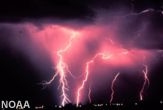Billion Dollar Weather Disasters

One way to track climate trends is to look at disasters above a given threshold. The National Climatic Data Center (NCDC) released last week its list of U.S. weather and climate disasters that have cost more than a billion dollars.
During the period between 1980 and 2004, there were 62 events in the U.S. that exceeded a billion dollars in costs and damages. These disasters include storms, droughts, forest fires and flooding. New to the list are the four hurricanes - Charley, Frances, Ivan and Jeanne - that hit the country last summer.
Although there has been a rise in the number of these costly events in the last decade or so, some of the most damaging catastrophes occurred in the 1980s.
It is important to note that there is no adjustment made for inflation when determining what events initially qualify for the list -- they had to cost $1 billion at the time they occurred. This results in a slightly greater probability that a more recent event will make the list.
However, in comparing the total cost from a year's disasters once they've made the list, the dollar amounts are normalized to reflect inflation. The total damages for all 62 events combined are over $390 billion in 2002 dollars.
Beach property
In an accompanying report, NCDC researchers Tom Ross and Neal Lott comment on one noticeable trend in the data: an increase in losses due to hurricanes.
Get the world’s most fascinating discoveries delivered straight to your inbox.
Accounting for almost a third of the billion-dollar list, tropical storms and hurricanes are the most frequent type of disaster in the years studied. This is partly due to an apparent upswing recently in the frequency of major hurricanes, which are defined by sustained wind speeds above 110 mph. The frequency of hurricanes is thought to ebb and flow in long-term cycles related to global climate factors.
The thirty years between 1961 and 1990 saw very few major hurricanes make landfall on the United States. This is in contrast to the 18 major hurricanes that struck between 1941 and 1960.
Starting with Hurricanes Hugo (1989) and Andrew (1992), there now appears to be a return to the active hurricane seasons of the '40s and '50s.
But in assessing the damages that these storms wrought, Ross and Lott stress that other factors must be included, such as population changes.
Americans have been moving to the coastlines in droves. Between 1940 and 1990, the coastal population of Florida has grown four times faster than the rate of the nation as a whole. The 426 counties along the Atlantic Ocean and Gulf of Mexico comprise 11 percent of the land in the continental U.S., but account for 45 percent of the population.
If a hurricane hits, there is more now to destroy. This is also true for other disasters, like flooding.
Heat danger
As dramatic as the recent hurricanes have been, it is perhaps surprising that droughts and heat waves cause the most damage and deaths.
In both 1980 and 1988, severe drought and heat ravaged the central and eastern parts of the country. They were the only billion dollar events on the list for those two years, yet they alone made 1980 and 1988 the two costliest years on the list - $48 and $62 billion, respectively, in 2002 dollars.
These heat waves also were the deadliest weather or climate events of the study period - with estimated deaths due to heat stress approaching 10,000 in each case.
In comparison, 1998 saw the most events - seven - but it was not an especially high year in total damages, with just over $20 billion in 2002 dollars.
Billion Dollar Disasters See the list: A chronology of extreme U.S. weather events
Weather or Not
Billion Dollar Disasters See the list: A chronology of extreme U.S. weather events
The Odds of Dying Nature is not your worst enemy
Global Disaster Hotspots Places really at risk
Tsunami Special Report Complete coverage
2005 Hurricane Forecast Another busy season



